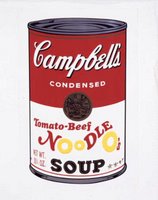TANG goes BANG inside The Head
SARATOGA SPRINGS - John Weber knew he was taking a risk.
"To me, one of the great things about having a 'teaching museum' at the Tang is that you can experiment with things like this," he said.
Still, the Tang's Dayton Director had no idea what to expect. Deliveries had been arriving by the truckload for weeks in preparation of the museum's mammoth new seven-month exhibition "And Therefore I Am." One of the most prominently visible displayable spaces had been purposely left vacant, slated to be filled at the last moment.
For this, artist Matt Mullican was to come to Saratoga and fill the space with an original, on-the-spot creation - while under hypnosis.
So last Monday the artist walked into the gallery, was met by a locally based hypnotherapist and promptly put under. Mullican picked up his black acrylic paints, turned to face the large blank wall, and for the next hour and 15 minutes the California-born artist drew while in a hypnotic trance.
"I watched the whole thing. Through it all, as he's drawing, he's visibly shaking and making all kinds of odd noises," said Weber, offering that the artist's under-hypnosis work and wide-awake work are very different in style. Mullican's drawings probe the subconscious of "that other person" he becomes while under hypnosis.
"It's very strange, and in a way makes us ask: what IS normal waking time?" Weber said.
Mullican's is one of nine contemporary artists' works in "And Therefore I Am." The exhibition, opening this weekend, is an art-meets-neuroscience display rooted in conveying - and questioning - the nature of human consciousness. The exhibit seeks to get inside your head while taking you out of your own mind and goes deep in the heart of your brain, pulling levers and flipping switches along the journey.
"What all these artists are getting at is, at times, disturbing," Weber said. "It is, at times creepy, and at other times, quite fun."
In Janet Cardiff and George Bures Miller's audio-video installation, "The Paradise Institute," viewers sit in the balcony of an old-fashioned theater that combines inner monologues, binaural audio recording technology and a film-noir video installation.
"The Paradise Institute" leaves viewers with the impression of being inside the narrator's head - or having the narrator inside yours, explains Weber, who first worked with the artists in the 1990s.
"People talk about it as being inside somebody else's head. So I thought it would be interesting to take Janet's work and George's work and take that 'being inside someone's head' and revolve the show around that," said Weber, who came to the Tang a little over a year ago after more than a decade as curator of the San Francisco Museum of Modern Art.
Other works on view include Sean Landers' language paintings, layering word-packed paintings in large block letters on top of each other.
"Sean works with automatic writing and surrealism," explained Weber, pointing to a painting with words blotted over by other words. Instead of erasing the first ones, he wrote over them, so it all is there in the work, Weber pointed out. "He's publicly exposing himself on the one hand, while protecting people on the other. It's important to him that it's all there."
Beth Campbell's sound-and-sculpture installation, "I Was Thinking" features an ordinary, interactive living room that broadcasts the artist's innermost thoughts out loud. The installation includes a clock, a radio and an answering machine.
A sweater is haphazardly thrown on a foot rest and a four-stack shelf is lined with candles, a telephone and a plate with the name "Mike" finger-scrawled in chocolate swirls. Socks, boots, a self-help paperback and a copy of Cosmopolitan Magazine lie next to a fully usable couch that is aimed at a TV set as an eight-minute sound piece ushers in six different types of audio - Campbell's varied inner thoughts flowing from one skull.
"We know a lot about the brain, but there's a whole lot more that we don't know," Weber said. "The works are about thought. We narrate our experiences in our own head all the time."
Rather than create an interactive setting to simulate what goes on inside the skull, conceptual artist Jochem Hendricks sent in the brain itself - or, a reasonable facsimile of it, anyway.
The computer-fabricated 3-D sculpture "Brain of the Artist" was created by the artist in collaboration with an MRI laboratory in Germany and is an exact replication of his brain.
Weber said it embodies the mystery of the entire exhibition: "how a three-pound mass of organic tissue inside our skull creates the animated, endlessly puzzling and fascinating sense of human identity and consciousness we each experience."
Shana Lutker documented her dreams through the entire calendar year of 2003, printed them on newsprint and created her installation, "Dream Newspaper." The exhibit looks like a library reading-room table whose reading material is entirely made up of her dreams.
In another exhibit, early video-artist pioneer Peter Campus is represented in his 1978 piece, "Head of a Man with Death on His Mind." And one of the more intense exhibits is depicted in Douglas Gordon's installation "30 seconds text." It takes just that long to create the experience that links body and brain, life and death, and the persistence of consciousness.
Weber first saw the piece eight years ago. It displays a brief wall text relating a gruesome experiment described in a 1905 archive of criminal anthropology. A special room was constructed at the Tang to house the piece.
"It shows the boundaries between consciousness - and the lack of it," explains Weber about the exhibit that inspires more questions than answers, including the most important one. "It's also about death," Weber said, "and that is the final question."
by Thomas Dimopoulos
The Saratogian


